Interfacial Stability between High-Entropy (La0.2Yb0.2Sm0.2Eu0.2Gd0.2)2Zr2O7 and Yttria-Stabilized Zirconia for Advanced Thermal Barrier Coating Applications
Abstract
:1. Introduction
2. Experimental Section
3. Results
4. Discussion
4.1. RE Diffusion
4.2. Phase Evolution
4.3. Implication of TBC Applications
5. Conclusions
Author Contributions
Funding
Institutional Review Board Statement
Informed Consent Statement
Data Availability Statement
Acknowledgments
Conflicts of Interest
References
- Karabaş, M. Production and characterization of Nd and Dy doped lanthanum zirconate-based thermal barrier coatings. Surf. Coat. Technol. 2020, 394, 125864. [Google Scholar] [CrossRef]
- Yang, J.; Shahid, M.; Zhao, M.; Feng, J.; Wan, C.; Pan, W. Physical properties of La2B2O7(B Zr, Sn, Hf and Ge) pyrochlore: First-principles calculations. J. Alloys Compd. 2016, 663, 834–841. [Google Scholar] [CrossRef]
- Bobzin, K.; Bagcivan, N.; Brögelmann, T.; Yildirim, B. Influence of temperature on phase stability and thermal conductivity of single- and double-ceramic-layer EB–PVD TBC top coats consisting of 7YSZ, Gd2Zr2O7 and La2Zr2O7. Surf. Coat. Technol. 2013, 237, 56–64. [Google Scholar] [CrossRef]
- Lutique, S.; Javorskỳ, P.; Konings, R.; Krupa, J.-C.; van Genderen, A.; van Miltenburg, J.; Wastin, F. The low-temperature heat capacity of some lanthanide zirconates. J. Chem. Thermodyn. 2004, 36, 609–618. [Google Scholar] [CrossRef]
- Xiang, H.; Xing, Y.; Dai, F.-Z.; Wang, H.; Su, L.; Miao, L.; Zhang, G.; Wang, Y.; Qi, X.; Yao, L.; et al. High-entropy ceramics: Present status, challenges, and a look forward. J. Adv. Ceram. 2021, 10, 385–441. [Google Scholar] [CrossRef]
- George, E.P.; Curtin, W.A.; Tasan, C.C. High Entropy Alloys: A Focused Review of Mechanical Properties and Deformation Mechanisms. Acta Mater. 2020, 188, 435–474. [Google Scholar] [CrossRef]
- Rost, C.M.; Sachet, E.; Borman, T.; Moballegh, A.; Dickey, E.C.; Hou, D.; Jones, J.L.; Curtarolo, S.; Maria, J.-P. Entropy-stabilized oxides. Nat. Commun. 2015, 6, 8485. [Google Scholar] [CrossRef] [PubMed]
- Zhang, R.-Z.; Reece, M.J. Review of high entropy ceramics: Design, synthesis, structure and properties. J. Mater. Chem. A 2019, 7, 22148–22162. [Google Scholar] [CrossRef]
- Zhou, L.; Li, F.; Liu, J.-X.; Hu, Q.; Bao, W.; Wu, Y.; Cao, X.; Xu, F.; Zhang, G.-J. High-entropy thermal barrier coating of rare-earth zirconate: A case study on (La0.2Nd0.2Sm0.2Eu0.2Gd0.2)2Zr2O7 prepared by atmospheric plasma spraying. J. Eur. Ceram. Soc. 2020, 40, 5731–5739. [Google Scholar] [CrossRef]
- Wang, J.; Wu, F.; Zou, R.; Wu, Y.; Gan, M.; Feng, J.; Chong, X. High-entropy ferroelastic rare-earth tantalite ceramic: (Y0.2Ce0.2Sm0.2Gd0.2Dy0.2)TaO4. J. Am. Ceram. Soc. 2021, 104, 5873–5882. [Google Scholar] [CrossRef]
- Luo, X.; Luo, L.; Zhao, X.; Cai, H.; Duan, S.; Xu, C.; Huang, S.; Jin, H.; Hou, S. Single-phase rare-earth high-entropy zirconates with superior thermal and mechanical properties. J. Eur. Ceram. Soc. 2022, 42, 2391–2399. [Google Scholar] [CrossRef]
- Zhao, Z.; Xiang, H.; Dai, F.-Z.; Peng, Z.; Zhou, Y. (La0.2Ce0.2Nd0.2Sm0.2Eu0.2)2Zr2O7: A novel high-entropy ceramic with low thermal conductivity and sluggish grain growth rate. J. Mater. Sci. Technol. 2019, 35, 2647–2651. [Google Scholar] [CrossRef]
- Liu, D.; Wang, Y.; Zhou, F.; Xu, B.; Lv, B. A novel high-entropy (Sm0.2Eu0.2Tb0.2Dy0.2Lu0.2)2Zr2O7 ceramic aerogel with ultralow thermal conductivity. Ceram. Int. 2021, 47, 29960–29968. [Google Scholar] [CrossRef]
- Leckie, R.; Krämer, S.; Rühle, M.; Levi, C. Thermochemical compatibility between alumina and ZrO2–GdO3/2 thermal barrier coatings. Acta Mater. 2005, 53, 3281–3292. [Google Scholar] [CrossRef]
- Karaoglanli, A.C.; Doleker, K.M.; Ozgurluk, Y. Interface failure behavior of yttria stabilized zirconia (YSZ), La2Zr2O7, Gd2Zr2O7, YSZ/La2Zr2O7 and YSZ/Gd2Zr2O7 thermal barrier coatings (TBCs) in thermal cyclic exposure. Mater. Charact. 2020, 159, 110072. [Google Scholar] [CrossRef]
- Mahade, S.; Curry, N.; Björklund, S.; Markocsan, N.; Nylén, P. Failure analysis of Gd2Zr2O7/YSZ multi-layered thermal barrier coatings subjected to thermal cyclic fatigue. J. Alloys Compd. 2016, 689, 1011–1019. [Google Scholar] [CrossRef]
- Mahade, S.; Curry, N.; Björklund, S.; Markocsan, N.; Nylén, P. Thermal conductivity and thermal cyclic fatigue of multilayered Gd2Zr2O7/YSZ thermal barrier coatings processed by suspension plasma spray. Surf. Coat. Technol. 2015, 283, 329–336. [Google Scholar] [CrossRef]
- Mensah, P.F.; Diwan, R.; Nandikolla, S.; Coker, O.; Sahoo, P. Thermo-Mechanical Study of the Role of Gd2Zr2O7 (GZ) in Improving Life of YSZ and GZ Double Layered Thermal Barrier Coatings. In Proceedings of the ASME 2012 International Mechanical Engineering Congress and Exposition, Houston, TX, USA, 9–15 November 2012; pp. 3083–3088. [Google Scholar]
- Luo, X.; Huang, R.; Xu, C.; Huang, S.; Hou, S.; Jin, H. Designing high-entropy rare-earth zirconates with tunable thermophysical properties for thermal barrier coatings. J. Alloys Compd. 2022, 926, 166714. [Google Scholar] [CrossRef]
- Shimamura, K.; Arima, T.; Idemitsu, K.; Inagaki, Y. Thermophysical properties of rare-earth-stabilized zirconia and zirconate pyrochlores as surrogates for actinide-doped zirconia. Int. J. Thermophys. 2007, 28, 1074–1084. [Google Scholar] [CrossRef]
- Xu, Z.; He, L.; Zhong, X.; Zhang, J.; Chen, X.; Ma, H.; Cao, X. Effects of Y2O3 addition on the phase evolution and thermophysical properties of lanthanum zirconate. J. Alloys Compd. 2009, 480, 220–224. [Google Scholar] [CrossRef]
- Aruna, S.; Balaji, N.; Rajam, K. Phase transformation and wear studies of plasma sprayed yttria stabilized zirconia coatings containing various mol% of yttria. Mater. Charact. 2011, 62, 697–705. [Google Scholar] [CrossRef]
- Zhu, J.; Meng, X.; Zhang, P.; Li, Z.; Xu, J.; Reece, M.J.; Gao, F. Dual-phase rare-earth-zirconate high-entropy ceramics with glass-like thermal conductivity. J. Eur. Ceram. Soc. 2021, 41, 2861–2869. [Google Scholar] [CrossRef]
- Li, F.; Zhou, L.; Liu, J.-X.; Liang, Y.; Zhang, G.-J. High-entropy pyrochlores with low thermal conductivity for thermal barrier coating materials. J. Adv. Ceram. 2019, 8, 576–582. [Google Scholar] [CrossRef]
- Wierzba, B. The Kirkendall Effect and Multi-component Diffusion Simulations. High Temp. Mater. Process. 2016, 36, 447–451. [Google Scholar] [CrossRef]
- Liu, X.; Che, J.; Yi, H.; Liang, G. Chemical compatibility between Ln2Zr2O7 (Ln = Nd, Sm, Gd) and tetragonal yttria stabilized zirconia after annealing at high temperatures. Mater. Lett. 2019, 234, 159–162. [Google Scholar] [CrossRef]
- Fabrichnaya, O.; Wang, C.; Zinkevich, M.; Aldinger, F.; Levi, C.G. Phase equilibria and thermodynamic properties of the ZrO2-GdO1.5-YO1.5 system. J. Phase Equilibria Diffus. 2005, 26, 591–604. [Google Scholar] [CrossRef]
- Andrievskaya, E.; Kornienko, O.; Bykov, A.; Sameliuk, A. Phase Equilibria in the ZrO2–La2O3–Gd2O3 System at 1600 °C. Sov. Powder Met. Met. Ceram. 2020, 58, 714–724. [Google Scholar] [CrossRef]
- Guo, X.; Li, L.; Park, H.-M.; Knapp, J.; Jung, Y.-G.; Zhang, J. Mechanical Properties of Layered La2Zr2O7 Thermal Barrier Coatings. J. Therm. Spray Technol. 2018, 27, 581–590. [Google Scholar] [CrossRef]
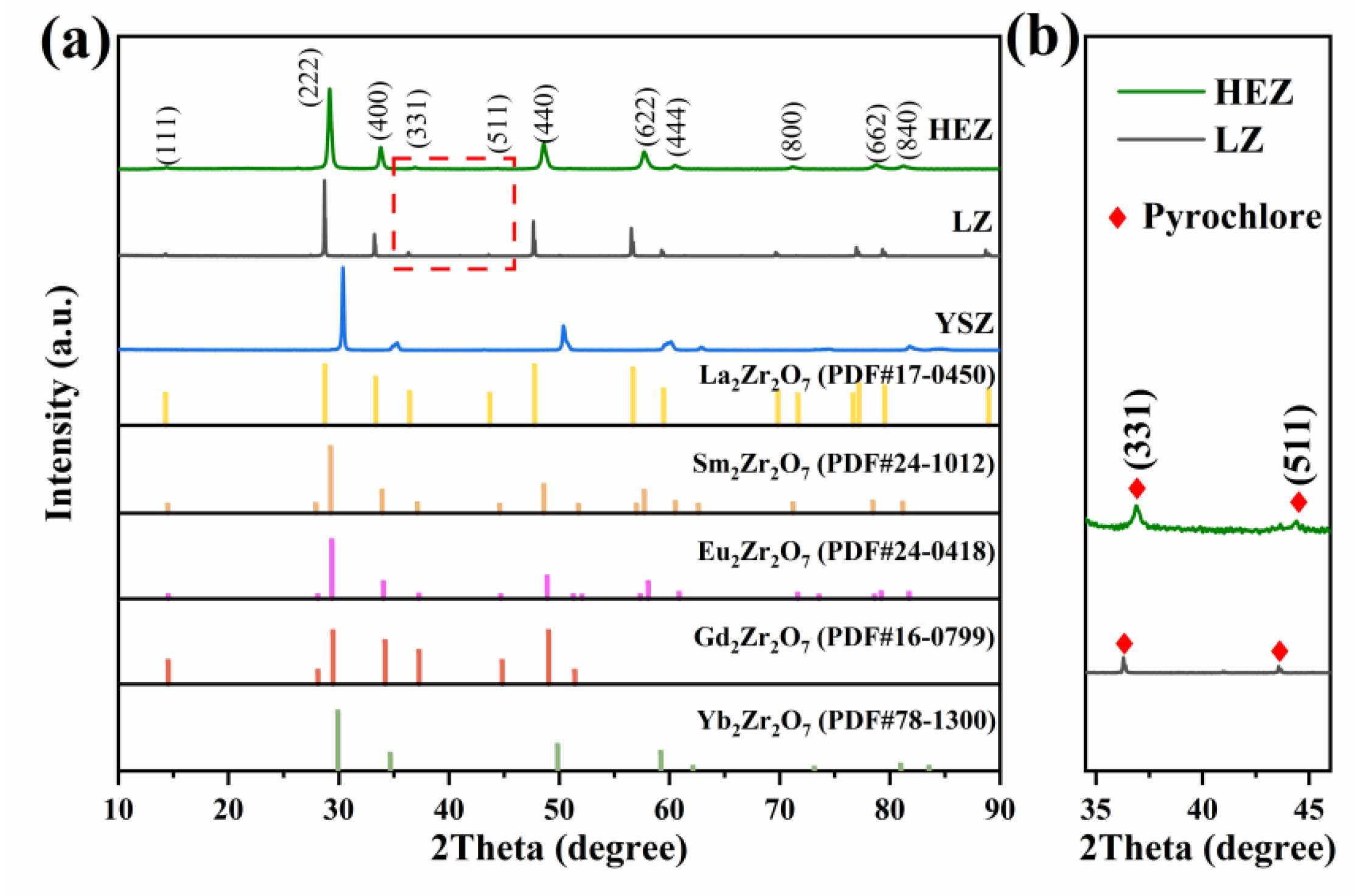


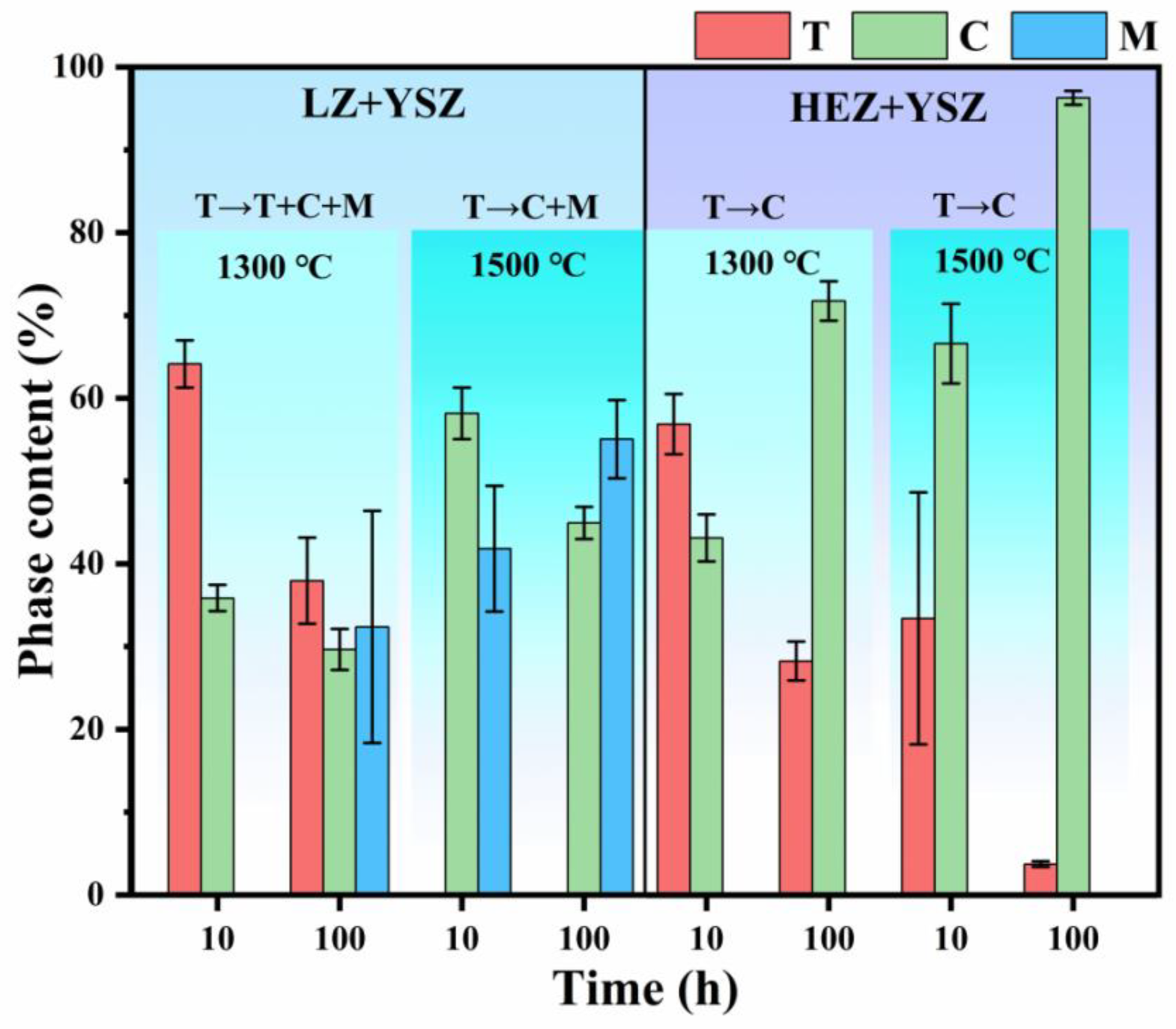

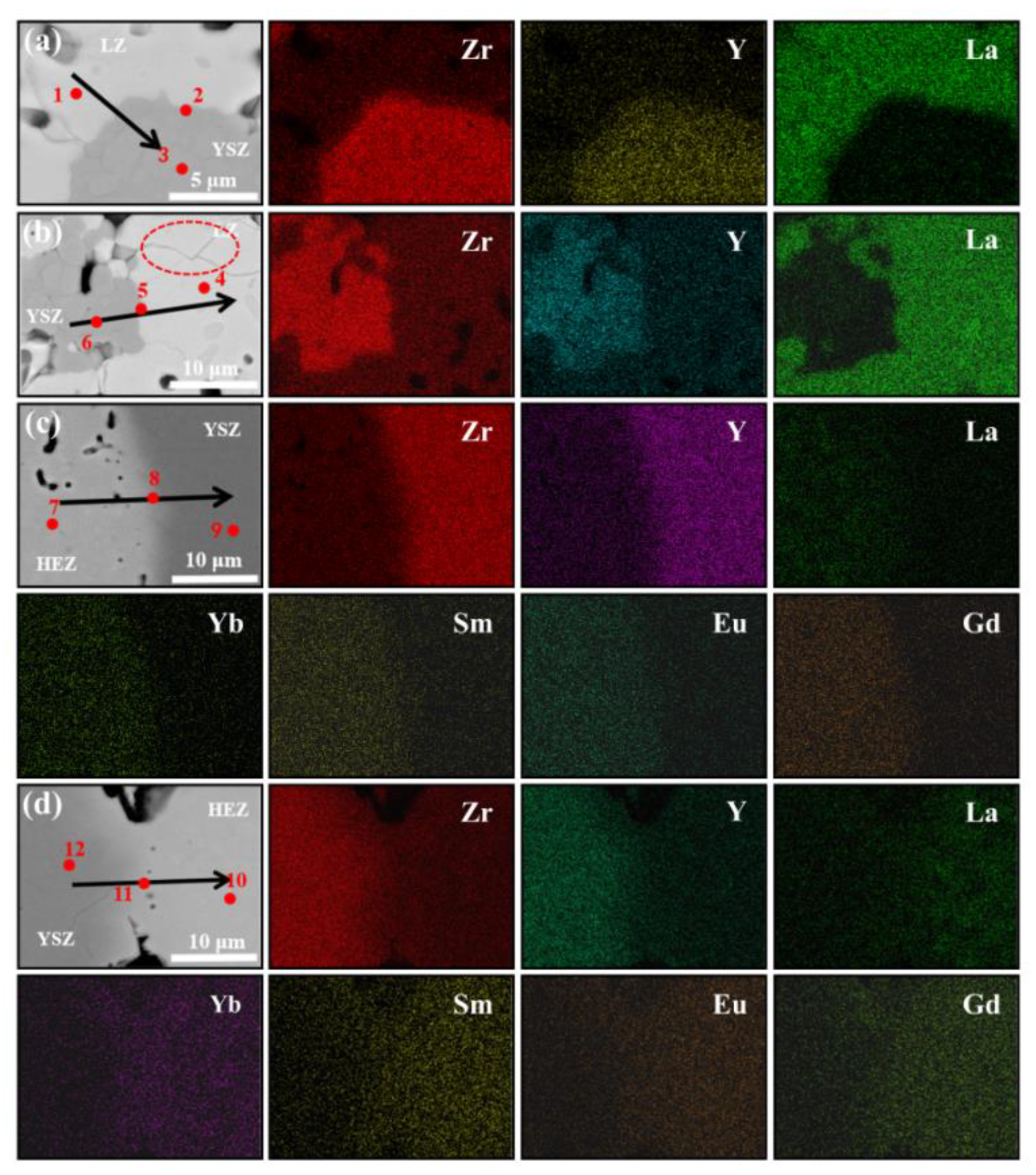
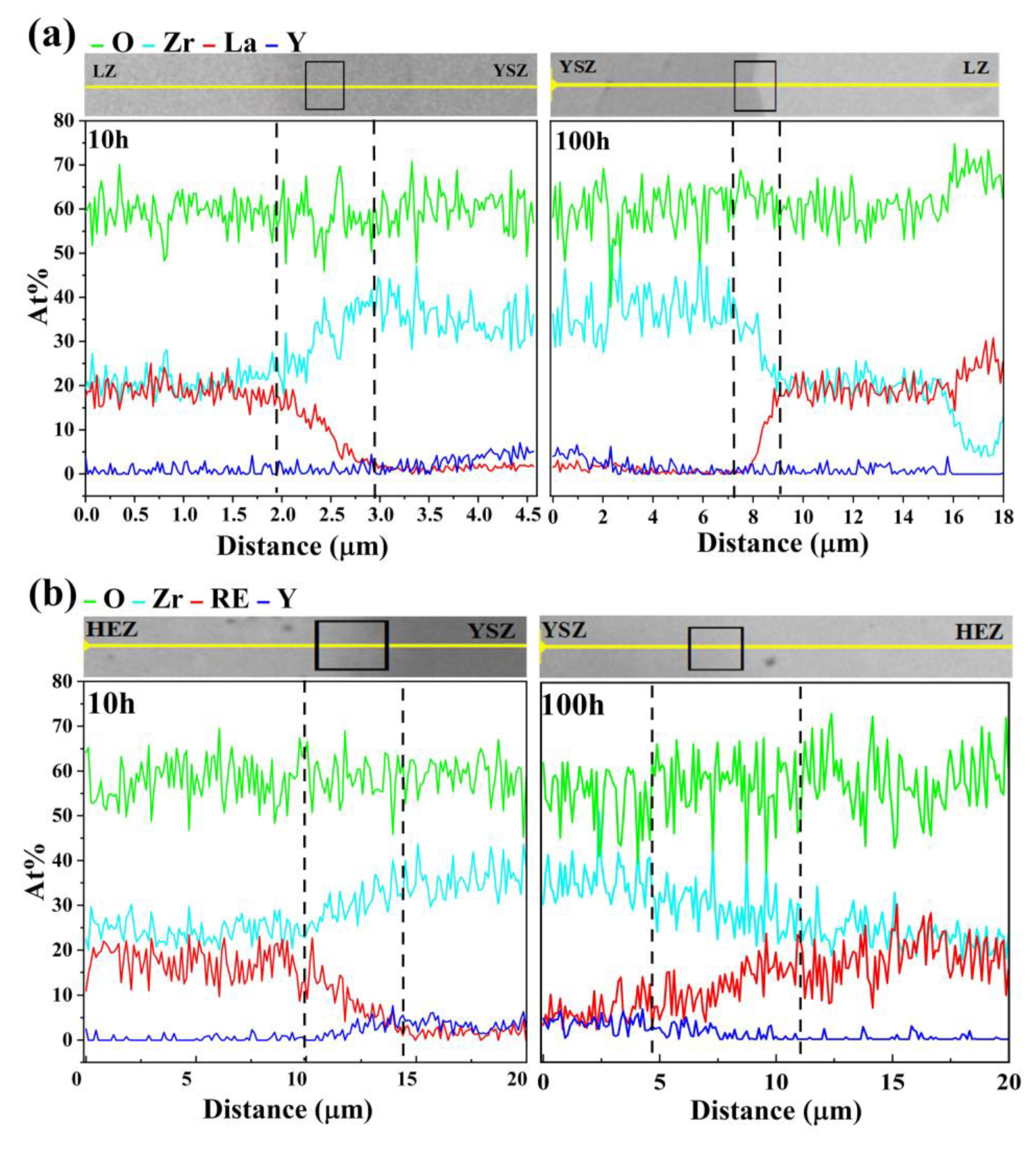
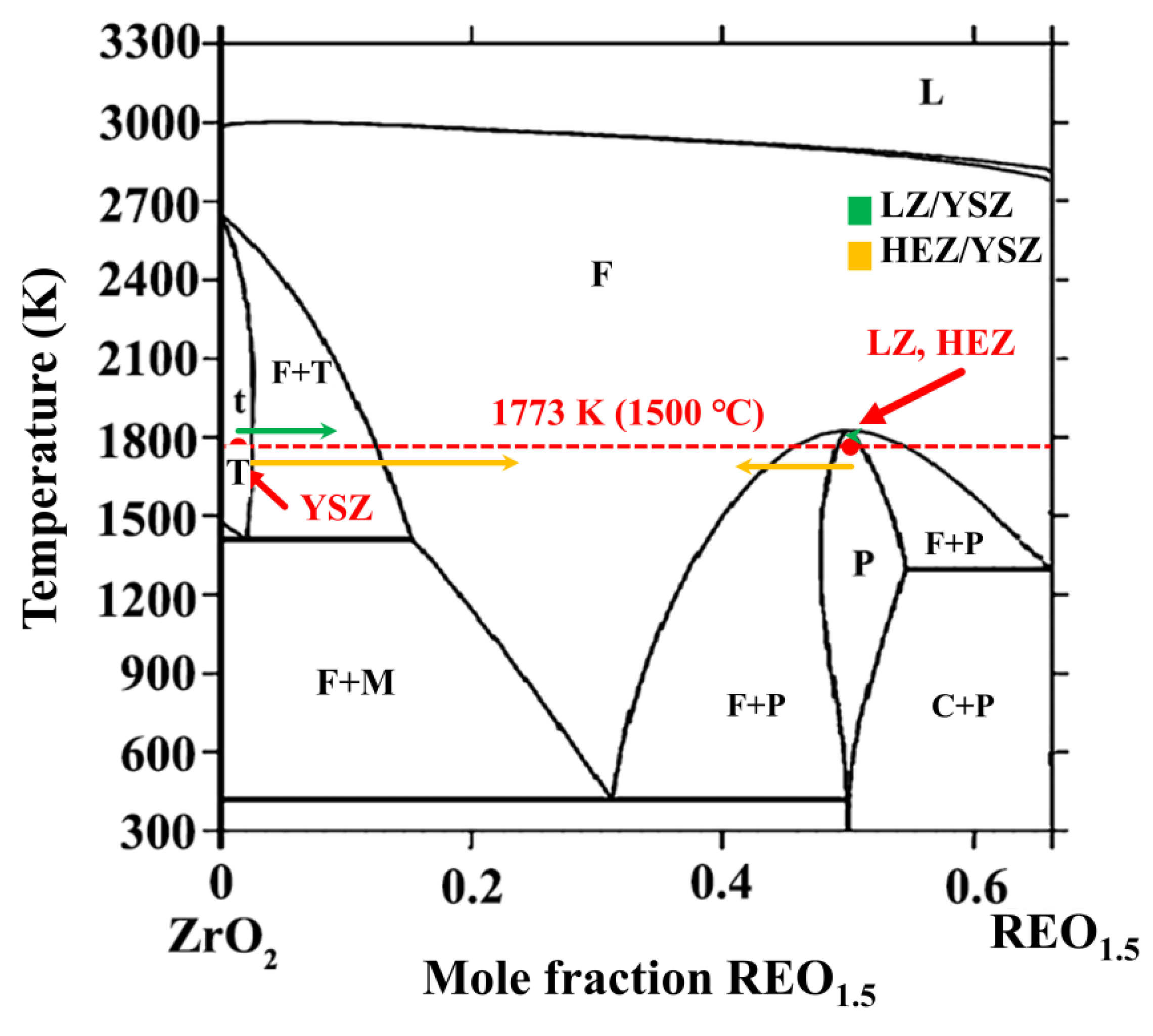

| O | Y | Zr | La | Sm | Eu | Gd | Yb | RE | ||
|---|---|---|---|---|---|---|---|---|---|---|
| Ionic Radius (Å) | 1.019 | 0.72 | 1.16 | 1.079 | 1.066 | 1.053 | 0.985 | |||
| LZ/YSZ (1500 °C 10 h) | 1 (LZ) | 59.6(2) | 0.6(2) | 20.9(4) | 18.9(4) | - | - | - | - | - |
| 2 (Interface) | 60.3(1) | 1.1(2) | 36.0(5) | 2.7(4) | - | - | - | - | - | |
| 3 (YSZ) | 61.2(0) | 3.8(2) | 33.6(3) | 1.4(1) | - | - | - | - | - | |
| LZ/YSZ (1500 °C 100 h) | 4 (LZ) | 60.2(1) | 0.9(4) | 20.4(2) | 18.5(1) | - | - | - | - | - |
| 5 (Interface) | 59.6(1) | 1.0(2) | 34.2(1) | 5.0(2) | - | - | - | - | - | |
| 6 (YSZ) | 62.0(4) | 4.2(1) | 32.2(2) | 1.6(3) | - | - | - | - | - | |
| HEZ/YSZ (1500 °C 10 h) | 7 (HEZ) | 58.7(1) | 0.0(3) | 25.0(4) | 2.4(3) | 3.2(2) | 3.4(0) | 3.6(3) | 3.7(0) | 16.3 |
| 8 (Interface) | 61.0(1) | 2.7(0) | 29.2(3) | 1.2(1) | 1.3(2) | 1.3(2) | 1.4(2) | 1.8(1) | 7.1 | |
| 9 (YSZ) | 60.8(5) | 3.5(1) | 32.8(4) | 0.7(2) | 0.6(3) | 0.5(2) | 0.6(0) | 0.6(2) | 3.1 | |
| HEZ/YSZ (1500 °C 100 h) | 10 (HEZ) | 58.9(2) | 0.0(0) | 21.5(2) | 5.3(5) | 4.2(3) | 3.9(1) | 3.8(4) | 2.5(3) | 19.6 |
| 11 (Interface) | 59.0(3) | 0.1(2) | 25.2(4) | 2.2(3) | 2.9(0) | 3.1(2) | 3.3(4) | 4.1(2) | 15.6 | |
| 12 (YSZ) | 62.1(2) | 3.0(0) | 28.8(1) | 1.1(3) | 1.2(3) | 1.2(3) | 1.2(3) | 1.5(1) | 6.1 | |
Disclaimer/Publisher’s Note: The statements, opinions and data contained in all publications are solely those of the individual author(s) and contributor(s) and not of MDPI and/or the editor(s). MDPI and/or the editor(s) disclaim responsibility for any injury to people or property resulting from any ideas, methods, instructions or products referred to in the content. |
© 2024 by the authors. Licensee MDPI, Basel, Switzerland. This article is an open access article distributed under the terms and conditions of the Creative Commons Attribution (CC BY) license (https://creativecommons.org/licenses/by/4.0/).
Share and Cite
Yang, G.; Han, C.; Chen, Y.; Guo, F.; Lu, J.; Zhou, M.; Luo, L.; Zhao, X. Interfacial Stability between High-Entropy (La0.2Yb0.2Sm0.2Eu0.2Gd0.2)2Zr2O7 and Yttria-Stabilized Zirconia for Advanced Thermal Barrier Coating Applications. Coatings 2024, 14, 269. https://doi.org/10.3390/coatings14030269
Yang G, Han C, Chen Y, Guo F, Lu J, Zhou M, Luo L, Zhao X. Interfacial Stability between High-Entropy (La0.2Yb0.2Sm0.2Eu0.2Gd0.2)2Zr2O7 and Yttria-Stabilized Zirconia for Advanced Thermal Barrier Coating Applications. Coatings. 2024; 14(3):269. https://doi.org/10.3390/coatings14030269
Chicago/Turabian StyleYang, Guojie, Chenbing Han, Ying Chen, Fangwei Guo, Jie Lu, Ming Zhou, Lirong Luo, and Xiaofeng Zhao. 2024. "Interfacial Stability between High-Entropy (La0.2Yb0.2Sm0.2Eu0.2Gd0.2)2Zr2O7 and Yttria-Stabilized Zirconia for Advanced Thermal Barrier Coating Applications" Coatings 14, no. 3: 269. https://doi.org/10.3390/coatings14030269





